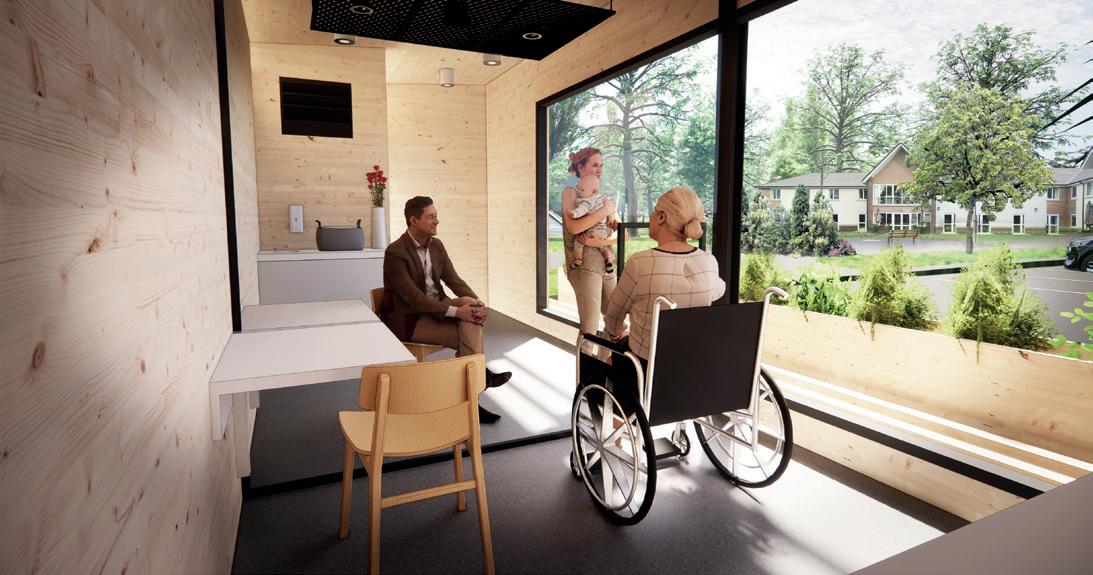
5 minute read
BUILD FOCUS: Timber & Surfacing
BUILD FOCUS:
TIMBER & SURFACING MATERIALS
Advertisement
FC&A rounds up the latest case studies, advice and stories from the industry’s leading professionals. This month’s Build Focus shines a light on how architects, designers and specifiers will have to change their way of thinking when it comes to specifying building materials in a post-pandemic world.
STUDIO Collection

Abet Laminati
SPECIFYING MATERIALS DURING A PANDEMIC
With the world still in the grip of COVID-19, the built environment is having to respond. While lockdown is easing, it is being done on the condition that social distancing and hygiene are top of the agenda for individuals and businesses. This means changes to the places we work, shop and relax; changes that are likely to remain until next year at least.
JAMES LATHAM
The biggest challenge for architects in the short-term is how they respond quickly to the effects of the pandemic and redesign spaces to help safeguard people from the virus. Material choice is under a huge amount of scrutiny now, for example: “Will the virus survive on the surface of this material? If so, how long for? Can it cope with a heavy cleaning regime?”
There is a lot of information available from suppliers and manufacturers, but how can architects cut through the noise to learn about and source new materials with suitable properties to help in the battle against the virus? Architects often like to work with existing suppliers and with materials they know and trust, which is understandable. However, the landscape is shifting rapidly, and new materials will need to come into play.
Where to begin? Anti-bacterial verses anti-microbial
If a surface is to remain safe in the post-COVID world, it ideally needs anti-microbial properties. However, this should not be confused with anti-bacterial. It is important to understand the differences. Anti-bacterial materials prevent bacteria from growing on their surface, while antimicrobial products halt the growth of bacteria and a broader range of viruses, organisms, protozoa and fungi such as mould or mildew. This broader performance makes this type of material significantly better for high-use surfaces and high traffic areas.
Some products have anti-microbial properties built in such as some advanced thermoplastics, like KYDEX. A homogeneous product, it can be moulded to any shape and colour matched, perfect for branded environments, such as retail or leisure uses, schools and corporate spaces.
Thanks to its hard-wearing nature, it can be used for a wide range of objects including desks, worktops, chairs and storage units. It is available in a number of bright colours, which are ideal to add a splash colour to the environment.
Others, like laminates, have anti-microbial properties added via a coating. One example is Abet Lamishield which contains silver-ions that help inhibit surface growth by 99.9%. When combined with good cleaning practices, this kind of product is highly effective.
Sector-by-sector challenges
Each sector has different challenges and; therefore, different materials are needed.
For example, public-facing businesses, particularly in the retail and leisure sectors, are adding sneeze guards to protect their staff and the public. Clear plastic screens have been popping up everywhere, especially around tills and customer serving points. However, many of these have been added without any flare or style, and in many cases, they are made from a flimsy clear plastic offering. When subjected to regular cleaning with tough detergent, they are going to scratch and start to look shabby before long.
By investing a little more in higher quality clear acrylics, you can get it right first time. Products like AcryBright are extremely hard-wearing and will stand the test of time, even in high use scenarios.
If a business, such as a gym or an office, needs screens to separate staff or users, but do not need them to be transparent, there are a number of thermoformable solid surface materials available. For example, Aristech Surfaces’ STUDIO Collection is available in a range of translucent colours, is durable and has hygienic properties. It can also be backlit to provide a unique ambience for the area.
The hospitality sector faces some different challenges, with hotels, in particular, needing to increase cleaning regimes. For hotels, it is the fast turnaround of rooms that is the biggest challenge. Many hotels are now looking at thermoformed bathroom pods and bedroom furniture as a solution.
Challenges of the health sector
With a high volume of potentially vulnerable people, hospitals have a very special challenge. Many surfaces need to be anti-microbial and hard-wearing. For that reason, the lower half of most hospital walls, doors, furniture and over-bed tray tables are all made of or coated in the aforementioned KYDEX.
It is damage-resistant and can withstand strong cleansers with no staining. Even graffiti can be removed from its surface without fading or surface damage. It also contains Microban

anti-microbial protection, which halts the growth of microbes and reduces the spread of infection.
It was extensively used in the NHS Nightingale programme to produce Integrated Panel Systems (IPS) for selfcontained handwash stations as well as overbed tables for each patient bay.
How to find out more
If you need to find out more information about these kinds of products, a good place to start is supplier websites. They often include case studies that show the materials in use, details about the product range and available options, and technical information such as testing, certification and performance-related data.
And while CPDs are no longer taking place face-to-face, do not forget the value of liaising directly with sales teams. Virtual tools such as webinars are becoming increasingly available and; of course, there is always the option to contact them directly. As product experts, they will be able to offer comprehensive guidance on materials, their properties and the best applications, as well as discuss your specific requirements.
As the world adapts, so must architects and designers. It is time to find the new normal when it comes to specifying materials.
KYDEX STUDIO Collection












